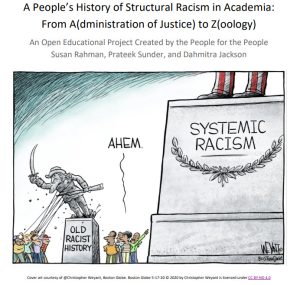A People’s History of Structural Racism in Academia From A(dministration of Justice) to Z(oology)
Description of the Resource:
The structural racism guidebook’s goal is to provide readers with a subject-by-subject overview of the role structural racism plays in each of the disciplines represented in the text. While the overviews presented are only snapshots of a much larger problem within higher education, this book serves as a survey of structural racism in higher education writ large.
Structural racism has shaped all social institutions in the creation of these United States. This guidebook covers 44 different subjects ranging from Administration of Justice, Biology, Career Technical Education, all the way to Zoology. Its goal is to briefly introduce the reader to the role structural racism plays in each of the academic disciplines, with the caveat that there is much more to tell. The goal is not to tell the whole story, merely to invite further investigation, as a primer is intended to do. Since the guidebook is openly-licensed, the hope is that readers will build upon, remix, and reuse its content to serve their educational needs.
Within broad subjects, there are also explorations of subdisciplines and some related subdisciplines are divided between chapters. For example, the Arts chapter explores racism within the performing arts, dance, visual arts, and art history. The Career Technical Education chapter discusses graphic design, multimedia studies, and fire technology.
How This Resource Integrates Diversity, Equity, and Inclusion Principles and Practices:
The Structural Racism Guidebook, A People’s History of Structural Racism in Academia: From A(dministration of Justice) to Z(oology), was written to call out the limits of higher education, specifically due to the ways in which structural racism and gender bias has shaped it from its inception. Higher education’s growth and development continue to be tainted by structural racism, which manifests as a lack of representation in students, faculty, research opportunities, and overall contributions.
The primary motivation to write this guidebook stemmed from a desire to create a less racist world overall but particularly in higher education. Many disciplines within higher education explore institutional racism and its impact on wider society, but this resource was created to explicitly recognize that higher education itself is a racist institution.
Tips, Tricks, and Advice from the Faculty Author(s) Regarding OER Creation:
From the beginning to the end, this project was intentional in its organization with a flat non-hierarchical structure. Supervisors have been intentional with compensating students fairly both in labor and attribution. This collaborative approach to working with students as co-authors and designers rather than constricting their efforts to stereotypical “student job” tasks resonated with the students, as is evident in the authenticity of the work they produced.
Students did move on during the writing process, so that is something faculty need to consider when beginning a project. The majority of this project was done over Zoom during the pandemic and as people left, others joined so it ended up working out. However, it would be advisable to have a concrete timeline with specific tasks and due dates.
It was critical to compensate students for their work. As a former student who worked for free for her professors, Dr. Rahman felt it was important to have funding for student authors. This compensation continued thanks to the CC ECHO grant. If she were to do it again without this grant, she would seek out ways to pay students in-house, whether it be financial-aid based or from funding from COM. Finding funding for students is an additional step but embodies the values of OER creation and open educational practices.
Check out OEG Voices 053: People and OER Projects from CC ECHO to hear about the author’s experience creating this OER and more!
 Author(s): Susan Rahman, Prateek Sunder, and Dahmitra Jackson
Author(s): Susan Rahman, Prateek Sunder, and Dahmitra Jackson